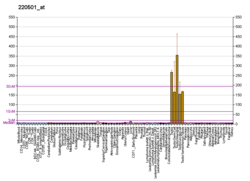Protein-coding gene in the species Homo sapiens
| ACTL7A |
|---|
|
| Available structures |
|---|
| PDB | Ortholog search: PDBe RCSB |
|---|
|
|
| Identifiers |
|---|
| Aliases | ACTL7A, actin like 7A |
|---|
| External IDs | OMIM: 604303; MGI: 1343051; HomoloGene: 7613; GeneCards: ACTL7A; OMA:ACTL7A - orthologs |
|---|
| Gene location (Human) |
|---|
 | | Chr. | Chromosome 9 (human)[1] |
|---|
| | Band | 9q31.3 | Start | 108,862,266 bp[1] |
|---|
| End | 108,863,756 bp[1] |
|---|
|
| Gene location (Mouse) |
|---|
 | | Chr. | Chromosome 4 (mouse)[2] |
|---|
| | Band | 4 B3|4 31.66 cM | Start | 56,743,413 bp[2] |
|---|
| End | 56,744,925 bp[2] |
|---|
|
| RNA expression pattern |
|---|
| Bgee | | Human | Mouse (ortholog) |
|---|
| Top expressed in | - left testis
- right testis
- sperm
- testicle
- metanephros
- tail of epididymis
- embryo
- right coronary artery
- human musculoskeletal system
- muscular system
|
| | Top expressed in | - spermatid
- seminiferous tubule
- spermatocyte
- embryo
- upper arm
- triceps brachii muscle
- islet of Langerhans
|
| | More reference expression data |
|
|---|
| BioGPS |  | | More reference expression data |
|
|---|
|
| Gene ontology |
|---|
| Molecular function | - structural constituent of cytoskeleton
- protein binding
| | Cellular component | - cytoplasm
- male germ cell nucleus
- Golgi apparatus
- motile cilium
- cytoskeleton
- nucleus
- protein-containing complex
| | Biological process | - cytoskeleton organization
| | Sources:Amigo / QuickGO |
|
| Orthologs |
|---|
| Species | Human | Mouse |
|---|
| Entrez | | |
|---|
| Ensembl | | |
|---|
| UniProt | | |
|---|
| RefSeq (mRNA) | | |
|---|
| RefSeq (protein) | | |
|---|
| Location (UCSC) | Chr 9: 108.86 – 108.86 Mb | Chr 4: 56.74 – 56.74 Mb |
|---|
| PubMed search | [3] | [4] |
|---|
|
| Wikidata |
| View/Edit Human | View/Edit Mouse |
|
Actin-like protein 7A is a protein that in humans is encoded by the ACTL7A gene.[5][6]
The protein encoded by this gene is a member of a family of actin-related proteins (ARPs) which share significant amino acid sequence identity to conventional actins. Both actins and ARPs have an actin fold, which is an ATP-binding cleft, as a common feature. The ARPs are involved in diverse cellular processes, including vesicular transport, spindle orientation, nuclear migration and chromatin remodeling. This gene (ACTL7A), and related gene, ACTL7B, are intronless, and are located approximately 4 kb apart in a head-to-head orientation within the familial dysautonomia candidate region on 9q31. Based on mutational analysis of the ACTL7A gene in patients with this disorder, it was concluded that it is unlikely to be involved in the pathogenesis of dysautonomia. The ACTL7A gene is expressed in a wide variety of adult tissues, however, its exact function is not known.[6]
References
- ^ a b c GRCh38: Ensembl release 89: ENSG00000187003 – Ensembl, May 2017
- ^ a b c GRCm38: Ensembl release 89: ENSMUSG00000070979 – Ensembl, May 2017
- ^ "Human PubMed Reference:". National Center for Biotechnology Information, U.S. National Library of Medicine.
- ^ "Mouse PubMed Reference:". National Center for Biotechnology Information, U.S. National Library of Medicine.
- ^ Chadwick BP, Mull J, Helbling LA, Gill S, Leyne M, Robbins CM, Pinkett HW, Makalowska I, Maayan C, Blumenfeld A, Axelrod FB, Brownstein M, Gusella JF, Slaugenhaupt SA (Jul 1999). "Cloning, mapping, and expression of two novel actin genes, actin-like-7A (ACTL7A) and actin-like-7B (ACTL7B), from the familial dysautonomia candidate region on 9q31". Genomics. 58 (3): 302–9. doi:10.1006/geno.1999.5848. PMID 10373328.
- ^ a b "Entrez Gene: ACTL7A actin-like 7A".
External links
Further reading
- Schafer DA, Schroer TA (2000). "Actin-related proteins". Annu. Rev. Cell Dev. Biol. 15: 341–63. doi:10.1146/annurev.cellbio.15.1.341. PMID 10611965.
- Rual JF, Venkatesan K, Hao T, et al. (2005). "Towards a proteome-scale map of the human protein-protein interaction network". Nature. 437 (7062): 1173–8. Bibcode:2005Natur.437.1173R. doi:10.1038/nature04209. PMID 16189514. S2CID 4427026.
- Gerhard DS, Wagner L, Feingold EA, et al. (2004). "The status, quality, and expansion of the NIH full-length cDNA project: the Mammalian Gene Collection (MGC)". Genome Res. 14 (10B): 2121–7. doi:10.1101/gr.2596504. PMC 528928. PMID 15489334.
- Humphray SJ, Oliver K, Hunt AR, et al. (2004). "DNA sequence and analysis of human chromosome 9". Nature. 429 (6990): 369–74. Bibcode:2004Natur.429..369H. doi:10.1038/nature02465. PMC 2734081. PMID 15164053.
- Garvalov BK, Higgins TE, Sutherland JD, et al. (2003). "The conformational state of Tes regulates its zyxin-dependent recruitment to focal adhesions". J. Cell Biol. 161 (1): 33–9. doi:10.1083/jcb.200211015. PMC 2172870. PMID 12695497.
- Coutts AS, MacKenzie E, Griffith E, Black DM (2003). "TES is a novel focal adhesion protein with a role in cell spreading". J. Cell Sci. 116 (Pt 5): 897–906. doi:10.1242/jcs.00278. PMID 12571287. S2CID 26602119.
- Strausberg RL, Feingold EA, Grouse LH, et al. (2003). "Generation and initial analysis of more than 15,000 full-length human and mouse cDNA sequences". Proc. Natl. Acad. Sci. U.S.A. 99 (26): 16899–903. Bibcode:2002PNAS...9916899M. doi:10.1073/pnas.242603899. PMC 139241. PMID 12477932.
















